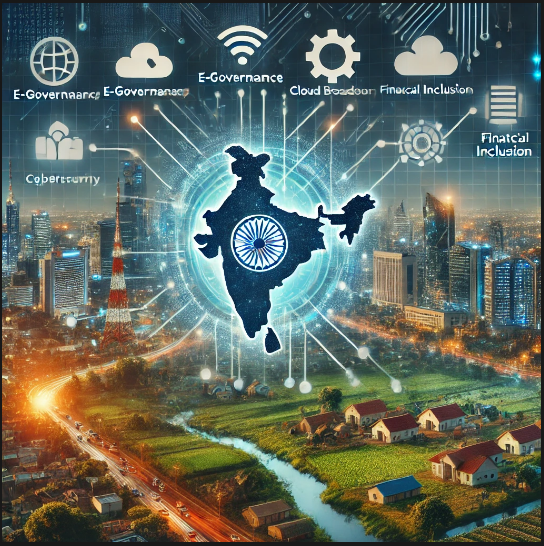Introduction
Digital India is a flagship initiative launched by the Government of India in 2015 to transform the country into a digitally empowered society and knowledge economy. This ambitious program aims to bridge the digital divide by ensuring digital access, digital literacy, and digital infrastructure across urban and rural areas. With a focus on e-Governance, digital services, and financial inclusion, Digital India plays a crucial role in India’s socio-economic development.
This article delves into the key pillars of Digital India, its impact, and the challenges hindering its full implementation.
Vision and Objectives of Digital India
The primary vision of Digital India is to provide seamless digital infrastructure, governance, and services to every citizen, ensuring transparency, efficiency, and inclusivity. The core objectives include:
- Providing broadband connectivity in all villages and remote areas.
- Enabling universal access to mobile connectivity.
- Boosting e-Governance through technology-driven solutions.
- Encouraging digital payments and financial inclusion.
- Promoting startups, innovation, and job creation in the digital sector.
- Enhancing cybersecurity and data protection mechanisms.
To achieve this vision, Digital India is structured around three key focus areas:
- Digital Infrastructure as a Core Utility to Every Citizen
- Governance and Services on Demand
- Digital Empowerment of Citizens
These objectives are realized through nine strategic pillars that drive the initiative forward.
Nine Pillars of Digital India
1. Broadband Highways
Digital connectivity is the backbone of any digital transformation. Under this initiative, the government aims to provide high-speed broadband connectivity to rural and urban areas. The BharatNet project is a key component, connecting over 2.5 lakh Gram Panchayats with optical fiber networks.
2. Universal Access to Mobile Connectivity
To ensure connectivity in remote and underserved areas, the government has taken initiatives to expand mobile networks. The focus is on covering all villages with mobile signals and reducing network gaps in remote areas.
3. Public Internet Access Program
This aims to provide affordable internet services across the country through:
- Common Service Centers (CSCs) – Digital kiosks that offer various government and private services in rural areas.
- Post Offices as Digital Service Hubs – Leveraging India Post offices to provide banking and digital services to rural populations.
4. e-Governance: Reforming Government through Technology
Digital India emphasizes e-Governance by integrating technology into governance for better efficiency and transparency. Initiatives include:
- DigiLocker – Secure cloud storage for important documents.
- MyGov – A citizen engagement platform for participatory governance.
- e-Hospital – Online appointment and health record services.
- e-Courts – Digitalization of the judiciary for faster case resolution.
5. e-Kranti: Electronic Delivery of Services
This pillar focuses on delivering essential services electronically, making governance more accessible. Major e-Kranti projects include:
- e-Education – Online learning platforms like SWAYAM and DIKSHA.
- e-Health – Digital health services, telemedicine, and Ayushman Bharat Digital Mission.
- e-Agriculture – Digital platforms for farmers, weather forecasts, and direct market linkages.
6. Information for All
Digital India ensures easy access to government data and information through:
- Open data portals like data.gov.in.
- Mobile apps for accessing government services.
- Digital literacy programs for spreading awareness.
7. Electronics Manufacturing
To reduce dependency on imports and boost domestic manufacturing, Digital India promotes initiatives such as:
- Make in India – Encouraging electronics and IT hardware manufacturing.
- Production-Linked Incentive (PLI) Scheme – Providing incentives for electronics manufacturing units.
- FAB Policy – Developing semiconductor fabrication plants in India.
8. IT for Jobs
This pillar focuses on skill development and employment generation in the IT and digital sectors. Key initiatives include:
- Skill India – Imparting digital skills to youth.
- National Digital Literacy Mission (NDLM) – Promoting basic digital literacy across rural and semi-urban areas.
9. Early Harvest Programs
Short-term projects aimed at quick results include:
- Biometric attendance systems in government offices.
- Wi-Fi hotspots in public places.
- E-mail-based communication within the government to reduce paperwork.
Impact of Digital India
Digital India has brought several transformative changes in governance, economy, and society. Some notable impacts include:
- Financial Inclusion
- The Jan Dhan-Aadhaar-Mobile (JAM) Trinity has revolutionized direct benefit transfers, ensuring government subsidies reach beneficiaries directly.
- The rise of UPI (Unified Payments Interface) has boosted digital transactions.
- Employment Generation
- Growth of startups and IT-based services has created jobs.
- Expansion of BPOs (Business Process Outsourcing) in small towns has opened new employment avenues.
- e-Governance and Transparency
- Digital platforms like RTI Online and GeM (Government e-Marketplace) have increased accountability.
- Blockchain and AI are being explored for governance efficiency.
- Healthcare and Education
- Telemedicine services have expanded medical access in remote areas.
- Online learning platforms like SWAYAM, NPTEL, and e-Pathshala have improved education accessibility.
Challenges and Roadblocks
Despite significant progress, several challenges hinder the full implementation of Digital India.
1. Digital Divide
- A significant population, especially in rural areas, still lacks access to smartphones and the internet.
- Gender and economic disparities further widen the digital gap.
2. Infrastructure Constraints
- Broadband penetration remains low in remote regions.
- Frequent internet outages affect service delivery.
3. Cybersecurity and Data Privacy
- Rising cyber threats pose a risk to data security.
- The need for stronger data protection laws is critical.
4. Digital Literacy and Awareness
- A large section of the population lacks basic digital skills.
- Misuse of digital platforms, cyber frauds, and misinformation remain major concerns.
5. Bureaucratic and Implementation Hurdles
- Slow execution of projects due to red tape and policy delays.
- Lack of coordination among different government agencies.
6. Dependence on Foreign Technology
- India still imports a large share of digital and semiconductor components.
- The need for indigenous innovation and research is crucial for self-reliance.
Way Forward
To overcome these challenges, India must adopt a multi-pronged approach:
- Strengthening Digital Infrastructure – Expanding fiber optic networks and 5G connectivity in rural areas.
- Enhancing Cybersecurity – Implementing strict data protection laws and improving awareness about cyber threats.
- Improving Digital Literacy – Integrating digital education into school curriculums and promoting community-based digital literacy programs.
- Encouraging Indigenous Innovation – Investing in semiconductor manufacturing and AI research.
- Streamlining Governance – Reducing bureaucratic delays and enhancing inter-departmental coordination.
Conclusion
Digital India has emerged as a transformative initiative, bridging the gap between technology and governance. While the journey has been commendable, addressing infrastructure, digital literacy, and cybersecurity challenges remains crucial. With continued efforts and technological advancements, India is well on its way to becoming a global digital powerhouse.
By ensuring last-mile connectivity and inclusivity, Digital India can truly empower every citizen and contribute to the nation’s socio-economic growth.




